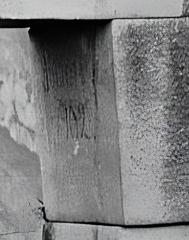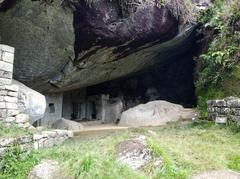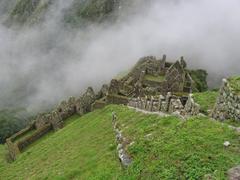
Discover the Magic of Machu Picchu in Cuzco, Peru
When to Visit: 14/08/2024
Start Your Journey with a Wow
Perched high in the Andes, Machu Picchu is a mysterious marvel that beckons adventurers and history buffs alike. Known as the ‘Lost City of the Incas,’ this 15th-century citadel promises an unparalleled journey back in time, offering a glimpse into the ingenuity and spiritual depth of the Inca civilization. Imagine standing amidst ancient stone ruins, enveloped by swirling clouds and the glistening Urubamba River far below. This is not just a tourist destination; it’s a time capsule of human achievement and a testament to the resilience of an empire that once dominated South America (Wikipedia, History.com).
Machu Picchu was likely constructed under the reign of the Inca emperor Pachacuti Inca Yupanqui around 1450. The site, with its polished dry-stone walls and intricate terraces, showcases the Inca’s advanced engineering skills and their deep connection to the natural world. This awe-inspiring citadel was not merely a royal estate but also a sacred site dedicated to the sun god Inti, reflecting the Inca’s sophisticated understanding of astronomy and religious practices (Smarthistory, Britannica).
Abandoned in the 16th century during the Spanish conquest, Machu Picchu remained shrouded in mystery until its rediscovery by American archaeologist Hiram Bingham in 1911. Today, it stands as a UNESCO World Heritage site and one of the new Seven Wonders of the World, drawing hundreds of thousands of visitors each year who come to explore its many sectors, from agricultural terraces to ceremonial sites (World History, Lonely Planet).
Whether you’re trekking the Inca Trail or navigating the more accessible routes, this guide aims to equip you with everything you need to make your visit to Machu Picchu unforgettable. From insider tips on the best time to visit and acclimatization advice to packing essentials and hidden hiking gems, get ready to unlock the secrets of this ancient marvel.
What’s Inside
- History of Machu Picchu
- Captivating Introduction
- Origins and Construction
- Purpose and Use
- Abandonment and Rediscovery
- Archaeological Significance
- Modern-Day Significance
- Radiocarbon Dating and Recent Discoveries
- Engineering Marvels
- Cultural and Spiritual Significance
- Conclusion
- Call to Action
- Visitor Tips for Machu Picchu
- Discovering the Lost City of the Incas
- Best Time to Visit
- Ticketing and Entry Regulations
- Acclimatization and Preparation
- Packing Essentials
- Guided Tours
- Transportation
- Hidden Hiking Gems
- On-Site Facilities
- Health and Safety
- Local Secrets and Quirky Tips
- Myth Busting and Surprises
- Engaging Itineraries
- Call to Action
- Unlocking the Secrets of Machu Picchu: Must-See Attractions
History of Machu Picchu
Captivating Introduction
Perched high in the Andes, Machu Picchu is a hidden marvel that whispers secrets of a bygone civilization. Known as the ‘Lost City of the Incas,’ this 15th-century citadel will transport you back in time with its breathtaking scenery and mystical aura.
Origins and Construction
Machu Picchu, often referred to as the ‘Lost City of the Incas,’ is a 15th-century Inca citadel located in the Eastern Cordillera of southern Peru, on a mountain ridge 2,430 meters (7,970 feet) above sea level (Wikipedia). The site is situated in the Machupicchu District within Urubamba Province, above the Sacred Valley, which is 80 kilometers (50 miles) northwest of Cusco. The Urubamba River flows past it, cutting through the Cordillera and creating a canyon with a tropical mountain climate.
The construction of Machu Picchu is attributed to the Inca emperor Pachacuti Inca Yupanqui, who ruled from 1438 to 1472 (History.com). It is believed that the site was built around 1450, during the height of the Inca Empire, which dominated western South America in the 15th and 16th centuries. The citadel was constructed using polished dry-stone walls, a hallmark of classical Inca architecture. Think of Machu Picchu as a time capsule of Inca ingenuity and spirituality. The site includes more than 150 buildings ranging from baths and houses to temples and sanctuaries (Britannica).
Purpose and Use
Machu Picchu was likely built as a royal estate for Pachacuti Inca Yupanqui. The location was chosen for its strategic and aesthetic value, perched high above the Urubamba River with sight lines to other mountain peaks, called apus, which were considered ancestral deities (Smarthistory). The site was intended as a place where the Inca emperor and his family could host feasts, perform religious ceremonies, and administer the affairs of the empire. It also served to establish a claim to the land that would be owned by his lineage after his death.
The site contains housing for elites, retainers, and a workforce that maintained the estate. It also features agricultural terraces, which were ingeniously designed to prevent landslides and ensure a stable food supply (Lonely Planet). The terraces and irrigation systems reflect the advanced engineering skills of the Inca civilization.
Abandonment and Rediscovery
Machu Picchu was abandoned around the time the Spanish began their conquest of the Inca Empire in the 1530s. There is no evidence that the conquistadors ever attacked or even reached the mountaintop citadel. Some historians suggest that the residents’ desertion occurred because of a smallpox epidemic introduced by the Spanish (History.com). The site remained largely unknown to the outside world until the American archaeologist Hiram Bingham brought it to international attention in 1911.
Bingham, guided by local indigenous farmers, stumbled upon the overgrown ruins and recognized their historical significance. His subsequent publications and photographs helped to popularize Machu Picchu, leading to increased interest and eventual restoration efforts (World History).
Archaeological Significance
Machu Picchu is one of the few major pre-Columbian ruins found nearly intact. It was designated a UNESCO World Heritage site in 1983 and is considered one of the new Seven Wonders of the World (Britannica). The site provides invaluable insights into Inca civilization, which had no written language. The names of the buildings, their supposed uses, and their inhabitants are the product of modern archaeologists based on physical evidence, including tombs at the site (Wikipedia).
The three primary structures at Machu Picchu are the Temple of the Sun, the Temple of the Three Windows, and the Intihuatana, a ritual stone associated with astronomical observations. These structures highlight the Inca’s sophisticated understanding of astronomy and their religious practices centered around the sun god Inti (Smarthistory).
Modern-Day Significance
Today, Machu Picchu is a major tourist attraction, drawing hundreds of thousands of visitors each year. The site stretches over an impressive 5-mile distance, featuring more than 3,000 stone steps that link its many different levels (History.com). Despite the heavy foot traffic, ongoing restoration efforts have helped to preserve the site for future generations.
Visitors to Machu Picchu can explore its various sectors, including agricultural terraces, residential areas, and ceremonial sites. The site’s layout and construction techniques continue to be a subject of study and admiration, reflecting the ingenuity and resilience of the Inca civilization (Lonely Planet).
Radiocarbon Dating and Recent Discoveries
Recent studies using advanced radiocarbon dating techniques, specifically AMS (Accelerator Mass Spectrometry), have revealed that Machu Picchu may have been occupied from around 1420 to 1530 AD, slightly earlier than previously believed (Wikipedia). This new timeline suggests that the site was in use for over a century, providing a longer period for its development and significance within the Inca Empire.
Historical research published in 2022 also claims that the site was probably called Huayna Picchu by the Inca people themselves, as it exists on the smaller peak of the same name (Wikipedia). This discovery adds another layer of complexity to our understanding of the site’s history and its place within Inca culture.
Engineering Marvels
The engineering prowess of the Inca is evident in the construction of Machu Picchu. The site was built with a sturdy underground foundation and tiered cropland to prevent landslides. The stonemasons carved and smoothed massive granite stones in such a precise manner that they could be pieced together without the use of mortar or any sort of melding agent (Lonely Planet). This technique, known as ashlar masonry, has allowed many of the structures to withstand heavy rains and frequent earthquakes over the centuries.
The site’s elaborate irrigation system, which includes channels and fountains, further demonstrates the Inca’s advanced understanding of hydraulics and their ability to manipulate the natural landscape to suit their needs (World History).
Cultural and Spiritual Significance
Machu Picchu was not just a royal estate but also a sacred site, probably dedicated to the sun god Inti. The location was chosen for its spiritual significance, with sight lines to other sacred peaks and its alignment with astronomical events (Smarthistory). The site’s design reflects the Inca’s deep connection to their environment and their belief in the sacredness of the natural world.
The presence of ritualistic and sacrificial areas within the citadel indicates that Machu Picchu was a center for religious ceremonies and spiritual practices. These elements highlight the Inca’s complex belief system and their efforts to maintain harmony with the cosmos (Lonely Planet).
Conclusion
Machu Picchu stands as a testament to the ingenuity, resilience, and spiritual depth of the Inca civilization. Its history, from its construction in the 15th century to its rediscovery in the 20th century, continues to captivate and inspire people around the world. As a UNESCO World Heritage site and one of the new Seven Wonders of the World, Machu Picchu remains a symbol of the enduring legacy of the Inca Empire (Britannica).
Call to Action
Ready to explore Machu Picchu? Download Audiala, our tour guide app, to unlock the secrets and stories of this ancient marvel. With beautifully crafted, concise yet deep audio guides, Audiala will enhance your visit and make your journey unforgettable.
Visitor Tips for Machu Picchu
Discovering the Lost City of the Incas
Picture this: You’re standing amidst ancient stone ruins, high in the Andes, with clouds swirling around you and the Urubamba River glistening far below. Welcome to Machu Picchu, a world wonder that’s as enigmatic as it is breathtaking. Let’s dive into the tips that will make your journey unforgettable!
Best Time to Visit
Machu Picchu dances to the tune of three distinct seasons: the dry season, the wet season, and the shoulder season. The sweet spot? April, May, September, and October—think gorgeous weather and fewer crowds (Travellers Worldwide). But beware: June 1st to October 15th is peak season, with a surge on December 30th and 31st (Visit South America). Peru’s winter (June to August) offers the driest weather (Travellers Worldwide).
Ticketing and Entry Regulations
Start planning early! As of 2024, tickets must specify a circuit and entry time—200 slots per time, and they sell like hotcakes (Travelbinger). Buy tickets on the TuBolet/Joinnus website, covering visits through October 15th and December 30th and 31st (Visit South America). Timings are strict; if your slot is 9:00 to 10:00 AM, you get an extra 45 minutes to enter (Visit South America).
Acclimatization and Preparation
Altitude can be a beast! Fly to Lima, then Cusco—the gateway to Machu Picchu. Spend a few days in Cusco to adjust (Savored Journeys). The journey involves flights, trains, buses, and walking—so gear up for an adventure (Savored Journeys).
Packing Essentials
Weather is a chameleon here, so pack a poncho or raincoat (The Only Peru Guide). Bring snacks and drinks; the sole snack bar can be pricey. La Boulangerie de Paris in Aguas Calientes has great box lunches (The Only Peru Guide). Wear long, light clothing and insect repellent to fend off bugs (The Only Peru Guide).
Guided Tours
Solo exploration is fun, but a guide brings history to life. They can be pre-arranged or hired on the spot (Savored Journeys). Expect to pay around S/.120 (US$ 50) for a two-hour tour (The Only Peru Guide).
Transportation
From Cusco, take a scenic 3.5-hour train ride to Aguas Calientes with Inca Rail or Peru Rail (Machu Picchu Travel Guide). Shuttle bus tickets from Aguas Calientes to Machu Picchu are best bought the night before to skip long lines (The Only Peru Guide).
Hidden Hiking Gems
Try the lesser-known hikes: Sun Gate (3 hours round trip), Inca Bridge (1 hour round trip)—both free. Huayna Picchu and Machu Picchu Mountain require tickets and are more challenging (The Only Peru Guide). Huayna Picchu limits entry to 400 people daily (The Only Peru Guide).
On-Site Facilities
Get your passport stamped at the small office past the entrance (The Only Peru Guide). A storage office near the main entrance holds belongings for 3 Soles (US$ 1) (The Only Peru Guide). Tinkuy Restaurant offers a buffet lunch from 11:30 AM to 3:00 PM for US$ 40 (The Only Peru Guide).
Health and Safety
A pharmacy and doctor’s service are available to the left of the entrance, operated by Clinca’s Pardo and San Jose from Cusco (The Only Peru Guide). Bring sun protection: hat, sunglasses, sunblock, and maybe even a small umbrella (The Only Peru Guide).
Local Secrets and Quirky Tips
- Only small backpacks (<20 liters) are allowed (The Only Peru Guide).
- Prefer hiking over shuttle buses? There’s a pathway up the switchback road—takes about an hour (The Only Peru Guide).
- Two days offer a fuller experience (The Only Peru Guide).
- Your passport is essential for entry (The Only Peru Guide).
Myth Busting and Surprises
Contrary to popular belief, Machu Picchu isn’t the “Lost City of the Incas”—that title belongs to Vilcabamba. Also, llamas aren’t just photogenic residents—they play a role in maintaining the grass!
Engaging Itineraries
Why not try a themed adventure? Follow the footsteps of Hiram Bingham, the explorer who rediscovered Machu Picchu in 1911, or embark on a spiritual journey to align with the energies of this sacred site.
Call to Action
Ready to explore Machu Picchu like a pro? Download the Audiala app for insider tips, guided tours, and more. Your adventure awaits!
Your Next Adventure Awaits
Machu Picchu is more than just a historical site; it’s a living testament to the ingenuity, spiritual depth, and resilience of the Inca civilization. From its strategic construction under Pachacuti Inca Yupanqui to its rediscovery by Hiram Bingham, the citadel continues to captivate and inspire visitors from around the globe. As you wander through its ancient stone pathways, you’ll find yourself transported to a time when the Inca Empire reigned supreme, their advanced engineering skills and deep spiritual beliefs evident in every corner of this magnificent site (Britannica, History.com).
The enduring allure of Machu Picchu lies not just in its historical significance but also in its breathtaking natural beauty. The site’s layout, with its agricultural terraces, residential areas, and ceremonial sites, reflects a harmonious blend of human ingenuity and the natural landscape (Smarthistory, Lonely Planet). Whether you’re scaling the heights of Huayna Picchu or exploring the lesser-known Inca Bridge, every step you take offers a new perspective on this ancient marvel.
Ready to explore Machu Picchu like a pro? Download the Audiala app for insider tips, guided tours, and more. Your adventure awaits!
Where to Learn More
- History of Machu Picchu Wikipedia, 2024, Unknown
- Machu Picchu Rediscovery History.com, 2024, History.com Editors
- Machu Picchu Facts Britannica, 2024, Britannica Editors
- Inca Civilization Smarthistory, 2024, Smarthistory Editors
- Machu Picchu Travel Tips Lonely Planet, 2024, Lonely Planet Editors
- Machu Picchu Rediscovery World History, 2024, World History Editors




